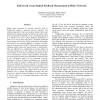Free Online Productivity Tools
i2Speak
i2Symbol
i2OCR
iTex2Img
iWeb2Print
iWeb2Shot
i2Type
iPdf2Split
iPdf2Merge
i2Bopomofo
i2Arabic
i2Style
i2Image
i2PDF
iLatex2Rtf
Sci2ools
102
click to vote
ISCC
2002
IEEE
2002
IEEE
End-to-end versus explicit feedback measurement in 802.11 networks
Higher layer protocols in wireless networks need to dynamically adapt to observed network response. The common approach is that each session employs end-to-end monitoring to estimate quantities of interest, like delay, delay jitter and available bandwidth. A less conventional approach is to employ lower layer explicit feedback mechanisms in place or in aid of end-to-end efforts. Available bandwidth measurements are known to follow multi-modal distributions and therefore are especially difficult to measure and filter, even in wired networks. In 802.11-based multi-hop networks obtaining usable end-to-end measurements is questionable. They are affected by a combination of a large number of transient variables due to the virtual carrier sense, head of line problems on each link and mobility. Motivated by this, we are developing a network explicit feedback mechanism. Our study of this accurate network feedback architecture aids in the cost/benefit analysis of an important trade-off: deploy...
Communications | Explicit Feedback Mechanism | ISCC 2002 | Layer Explicit Feedback | Network Feedback |
| Added | 15 Jul 2010 |
| Updated | 15 Jul 2010 |
| Type | Conference |
| Year | 2002 |
| Where | ISCC |
| Authors | Manthos Kazantzidis, Mario Gerla |
Comments (0)

